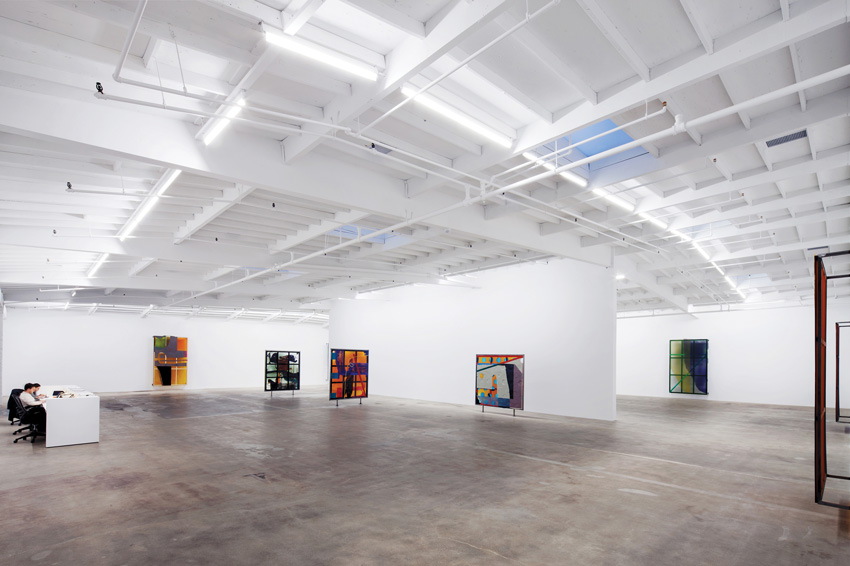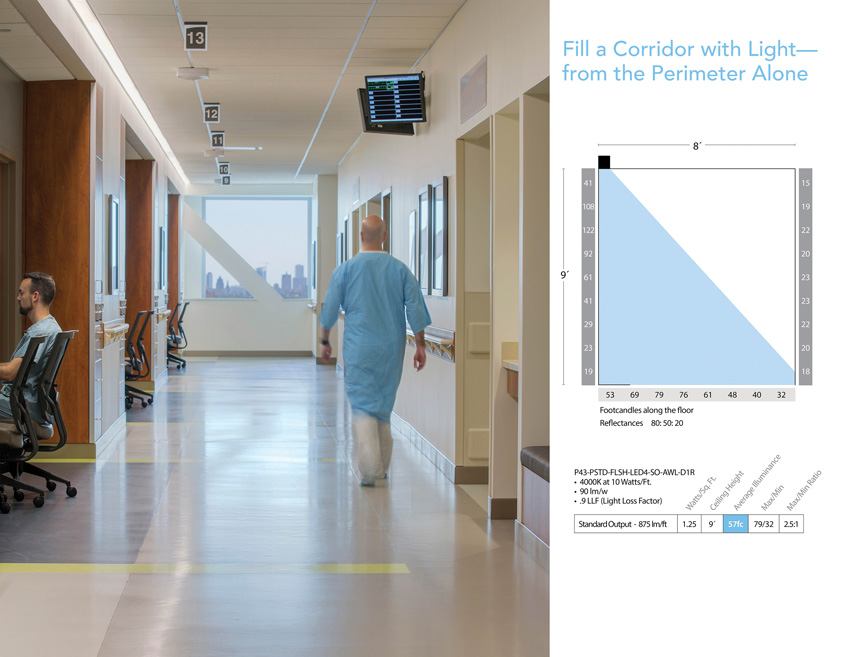Linear Lighting Frenzy
More Control: Adjusting Direct and Indirect Independently
Some direct/indirect fixtures have LED arrays installed horizontally to achieve a ceiling wash effect but do not allow users to control direct and indirect light separately. When occupants dim the direct lighting, the indirect dims as well. For AV projection and other applications, separate control is preferred, where direct lighting can be dimmed or turned off while the uplight is left on to illuminate the space enough for note-taking. Separate dimming is also desirable to adjust for daylight changes, saving energy and vastly improving the user experience.
Vertical Illumination Creates a More Robust Palette
As vertically oriented creatures who are accustomed to our primary light source (the sun) creating bright skies, we desire vertical illumination indoors as well. Unfortunately, budgets seldom allow for the involvement of lighting designers trained to create meticulously lighted spaces where wall/ceiling illumination is a key component. These new optics-driven, energy-efficient options from wall washers to grazers provide far more visual continuity, particularly in open office environments. Depending on the need, lenses are crafted to spread the light in a wider distribution or concentrate it to highlight a focal point, all achieving uniform illumination without the striations and hot spots of the previous iterations.
Wall Wash Bathes Walls with Light, Highlighting Artwork
Our workplaces need vertical illumination to bring our eyes up, but asymmetric lighting has typically been highly inefficient, difficult to control and expensive. The wall wash is an application that enhances artwork or simply the wall itself with a dimensional effect, drawing the eye to the focal point with just the right amount of highlight, while flattening the appearance of the wall.
Wall washes are typically placed 18 inches to 4 feet away from a wall surface; in some cases with taller ceilings, they are a bit further away from the wall. It’s a subtle effect that piques visual interest without disrupting the balance of the vertical plane.
LED optics now eliminate the need for unsightly mechanical kickers and open cavities. These smarter new fixture designs reflect a significant amount of the emitted light instead of absorbing it. Instead of bouncing around inside the fixture, the light is directed out in a controlled manner. Just a few years ago, asymmetric wall wash luminaires were typically 40 to 50 lumens per watt (lm/w), but they now are more often 80 to 100 lm/w with smoother distribution of light as well.

Photo: Kelly Barrie Studio
A small but powerful linear wall wash was utilized for this art gallery where the fixtures were mounted 20 feet high and 8 feet away from the walls—and provided beautifully lit walls along with soft, even general illumination (IES award winner).
Architect: Standard Architecture
Lighting Designer: Kugler Ning
Photographer: Kelly Barrie Studio
Tight, Focused Wall Grazer Beam Brings Out Architectural Features
In scenarios where there’s a textural wall detail to be highlighted, the wall grazer evenly illuminates and accents key details. Typically placed flush to the wall, the wall grazer visually widens the space, elevating the visual drama of details from natural materials like brick or stone, or any type of tinted or textured architectural accent. Linear LED wall grazing has usually been achieved only in recessed or regressed fixtures because of the way discrete optics were mounted to LED strip lights, but suspended and wall-mounted wall grazing is now easily achievable.

Photo rendering of a wall mounted wall grazing fixture with foot candle distribution down the wall
Perimeter Fill: Ideal for Hospital Hallways
A new optic, the powerful perimeter fill is superior to traditional perimeter fixtures for washing hospital corridors in light. Its outstanding distribution qualities allow it to illuminate 8-foot-wide corridors from just one side instead of the typically inefficient cove or perimeter lighting needed along both sides. The perimeter fill optic results in cutting the necessary number of fixtures by 50 percent for significant savings in both energy and materials costs.
Froedtert Hospital in Wauwatosa, Wisconsin, installed fixtures with perimeter fill optics along one side of its corridors, meeting the stringent 50 foot candle requirements across the entire corridor and reducing the number of fixtures needed by half.

Photo: Tom Rossiter
Froedtert Hospital perimeter fill optic illuminating an 8-foot-wide corridor from one side of the perimeter and the foot-candle calculation for this project
Architect: Cannon Design
Photographer: Tom Rossiter
Linear LED fixtures that offer perimeter fill distribution patterns are available in recessed and wall-mounted configurations, in 4-inch and 2.5-inch apertures. The wall-mounted fixtures are also available in models that provide indirect illumination as well, washing the corridor ceiling in light and enhancing the overall glow.
Scaling Down with Miniaturization
In the days of fluorescent lighting, 6-foot and 4-foot apertures were the most common linear apertures, with 2.5 inches being about the smallest possible. But because LED is a much smaller form factor, lines of light as narrow as 1/2 inch have become available. So these sleek, minimal lines of light can become an engaging graphic element, especially in combination with the organic curvilinear trend. The downside is their limited light distribution, which means foot candle requirements often cannot be met without using significantly more fixtures or pushing so much light that the fixture becomes too bright and a source of glare. So while the creative possibilities are intriguing, attempting to illuminate commercial spaces with apertures smaller than about 2 inches remains challenging, even with tiny LED light sources.
Dialing Up the Whimsy with Organic Form Factors
Playful, curvilinear shapes are appearing more frequently, from donut-shaped Os to gentle arcs of light. A purely aesthetic play, these whimsical new shapes are more of a decorative trend since the optics are subpar and they’re expensive to produce.









